Acoustic Comfort in Virtual Inner Yards with Various Building Facades
Abstract
:1. Introduction
2. Experimental Concept
3. Experimental Design and Setup
3.1. Listening Test Facility
3.2. Signal Processing and Room Acoustic Simulation
3.3. Reference Inner Yard
3.4. Validation
3.5. Experimental Sessions
3.6. Listening Test Software, Procedure, and the Comfort Scale
3.7. Pilot Experiments
3.8. Statistical Analysis
- Repeated-measures multi-factorial analysis of variance (ANOVA), corrected by the Greenhouse–Geisser method.
- Post hoc pairwise comparisons by Fisher’s protected least significant difference (LSD) test, corrected by the Bonferroni method.
- Linear mixed-effects models for further combined analysis of variables of different types; i.e., categorical variables, covariates, and random intercept (comparison of the models by means of Akaike information criterion (AIC) [47] and Bayesian information criterion (BIC) [48]; i.e., choosing the model with the lowest AIC/BIC).
4. Experiment 1
4.1. Method
4.1.1. Hypotheses
- Facade changes affect short-term acoustic comfort.
- Short-term acoustic comfort depends on sound source.
- Short-term acoustic comfort depends on observer position.
4.1.2. Experimental Design
4.1.3. Stimuli
4.1.4. Subjects
4.2. Results
5. Experiment 2
5.1. Method
5.1.1. Hypotheses
- Short-term acoustic comfort depends on the absorption coefficient.
- Short-term acoustic comfort depends on the sound source.
- Short-term acoustic comfort is different at different balconies (i.e., floors).
5.1.2. Experimental Design
5.1.3. Stimuli
5.1.4. Subjects
5.2. Results
6. Experiment 3
6.1. Method
6.1.1. Hypotheses
- Short-term acoustic comfort depends on the absorption coefficient ().
- Short-term acoustic comfort depends on the sound source.
- Using absorbing materials on the balcony ceiling affects short-term acoustic comfort.
6.1.2. Experimental Design
6.1.3. Stimuli
6.1.4. Subjects
6.2. Results
7. Discussion
- Generally, increasing would be associated with decreased acoustic comfort.
- In order to use the bipolar scale appropriately, it is important that an appropriate (moderate) range is chosen. Too many stimuli with high (or equivalently a high mean ) can cause positive skewness and would not allow subjects to use the scale properly.
- If a high mean is not avoidable, it might be more appropriate to switch to a unipolar (negative) scale, such as the 11-point ICBEN annoyance scale [49]. This might be more practical, as subjects would more likely experience discomfort (rather than comfort).
- Although using a lower range (e.g., mean = 45 dB(A)) might be tempting and would probably lead to higher acoustic comfort, the ecological validity of the experiment should be taken into account. Note that the stimuli of this study were not calibrated, but normalized to the A-weighted level of the signal with the largest maximum absolute amplitude and this marks one of the limitations of this study.
8. Conclusions
Author Contributions
Funding
Acknowledgments
Conflicts of Interest
Abbreviations
| AIC | Akaike information criterion |
| ANOVA | Analysis of variance |
| BIC | Bayesian information criterion |
| H0 | Null hypothesis |
| ICBEN | International Commission on Biological Effects of Noise |
| A-weighted equivalent continuous sound pressure level | |
| A-weighted FAST response maximum sound pressure level | |
| LSD | Fisher’s protected least significant difference |
| SPL | Sound pressure level |
References
- ISO 1996-1:2016. Acoustics—Description, Measurement and Assessment of Environmental Noise—Part 1: Basic Quantities and Assessment Procedures; International Organization for Standardization: Geneva, Switzerland, 2016. [Google Scholar]
- ISO 1996-2:2017. Acoustics—Description, Measurement and Assessment of Environmental Noise—Part 2: Determination of Sound Pressure Levels; International Organization for Standardization: Geneva, Switzerland, 2017. [Google Scholar]
- WHO. Environmental Noise Guidelines for the European Region; WHO Regional Office for Europe: Copenhagen, Denmark, 2018; Available online: http://euro.who.int/__data/assets/pdf_file/0008/383921/noise-guidelines-eng.pdf?ua=1 (accessed on 15 January 2019).
- ISO 12913-1:2014. Acoustics—Soundscape—Part 1: Definition and Conceptual Framework; International Organization for Standardization: Geneva, Switzerland, 2014. [Google Scholar]
- ISO 12913-2:2018. Acoustics—Soundscape—Part 2: Data Collection and Reporting Requirements; International Organization for Standardization: Geneva, Switzerland, 2018. [Google Scholar]
- Kang, J. Urban Sound Environment, 1st ed.; Taylor & Francis Group: Milton Park, Oxfordshire, UK, 2017; pp. 1–304. [Google Scholar]
- Schafer, R.M. The Soundscape: Our Sonic Environment and the Tuning of the World, 1st ed.; Destiny Books: Rochester, VT, USA, 1993; pp. 1–320. [Google Scholar]
- Brown, A.L.; Gjestland, T.; Dubois, D. Acoustic Environments and Soundscapes. In Soundscape and the Built Environment; Kang, J., Schulte-Fortkamp, B., Eds.; CRC Press: Boca Raton, FL, USA, 2016; pp. 1–16. [Google Scholar]
- Battaglia, P.L. Achieving acoustical comfort in restaurants. In Proceedings of the 168th Meeting of the Acoustical Society of America, Indianapolis, IN, USA, 27–31 October 2014. [Google Scholar]
- Thomas, P.; Aletta, F.; Vander Mynsbrugge, T.; Filipan, K.; Dijckmans, A.; De Geetere, L.; Botteldooren, D.; Petrovic, M.; De Vriendt, P.; Van De Velde, D.; et al. Evaluation and improvement of the acoustic comfort in nursing homes: A case study in Flanders, Belgium. In Proceedings of the Euronoise 2018, Crete, Greece, 27–31 May 2018. [Google Scholar]
- Xiao, J.; Aletta, F. A soundscape approach to exploring design strategies for acoustic comfort in modern public libraries: A case study of the Library of Birmingham. Noise Mapp. 2016, 3, 264–273. [Google Scholar] [CrossRef]
- Brown, A.L.; Kang, J.; Gjestland, T. Towards standardization in soundscape preference assessment. Appl. Acoust. 2011, 72, 387–392. [Google Scholar] [CrossRef]
- Coelho, J.L.B. Approaches to Urban Soundscape Management, Planning, and Design. In Soundscape and the Built Environment; Kang, J., Schulte-Fortkamp, B., Eds.; CRC Press: Boca Raton, FL, USA, 2016; pp. 197–214. [Google Scholar]
- Sturm, U.; Bürgin, M. Stadtklang—Wege zu Einer Hörenswerten Stadt. Report, Kompetenzzentrum Typologie und Planung in Architektur (CCTP); vdf Hochschulverlag AG: Zurich, Switzerland, 2016. [Google Scholar]
- Yang, W.; Kang, J. Acoustic comfort evaluation in urban open public spaces. Appl. Acoust. 2005, 66, 211–229. [Google Scholar] [CrossRef]
- Kang, J.; Zhang, M. Semantic differential analysis of the soundscape in urban open public spaces. Build. Environ. 2010, 45, 150–157. [Google Scholar] [CrossRef]
- Iachini, T.; Maffei, L.; Ruotolo, F.; Senese, V.P.; Ruggiero, G.; Masullo, M.; Alekseeva, N. Multisensory Assessment of Acoustic Comfort Aboard Metros: A Virtual Reality Study. Appl. Cogn. Psychol. 2012, 66, 757–767. [Google Scholar] [CrossRef]
- Schulte-Fortkamp, B. The quality of acoustic environments and the meaning of soundscapes. In Proceedings of the 17th International Conference on Acoustics (ICA), Rome, Italy, 2–7 September 2001. [Google Scholar]
- Yang, W.; Kang, J. Acoustic Comfort and Psychological Adaptation as a Guide for Soundscape Design in Urban Open Public Spaces. In Proceedings of the 17th International Conference on Acoustics (ICA), Rome, Italy, 2–7 September 2001. [Google Scholar]
- Vardaxis, N.-G.; Bard, D.; Persson Waye, K. Review of acoustic comfort evaluation in dwellings—Part I: Associations of acoustic field data to subjective responses from building surveys. Build. Acoust. 2018, 25, 151–170. [Google Scholar] [CrossRef]
- Vardaxis, N.-G.; Bard, D. Review of acoustic comfort evaluation in dwellings: Part II—Impact sound data associated with subjective responses in laboratory tests. Build. Acoust. 2018, 25, 171–192. [Google Scholar] [CrossRef]
- Vardaxis, N.-G.; Bard, D. Review of acoustic comfort evaluation in dwellings: Part III—Airborne sound data associated with subjective responses in laboratory tests. Build. Acoust. 2018, 25, 289–305. [Google Scholar] [CrossRef]
- Maag, T.; Kocan, T.; Bosshard, A. Klangqualität für Offentliche Stadt-und Siedlungsräume; Baudirektion Kanton Zurich: Zurich, Switzerland, 2016; Available online: https://tba.zh.ch/internet/baudirektion/tba/de/laerm/formulare_merkblaetter.html (accessed on 15 January 2019).
- Maag, T.; Kocan, T.; Bosshard, A. The sonic public realm—Chances for improving the sound quality of the everyday city. In Proceedings of the INTER-NOISE and NOISE-CON Congress and Conference 2016, Hamburg, Germany, 21–24 August 2016. [Google Scholar]
- Maag, T. Integrated urban sound planning—From noise control to sound quality for the everyday city. In Proceedings of the INTER-NOISE and NOISE-CON Congress and Conference 2017, Hong Kong, China, 27–30 August 2017. [Google Scholar]
- Yang, H.-S.; Kim, M.-J.; Kang, J. Acoustic characteristics of outdoor spaces in an apartment complex. Noise Control Eng. J. 2013, 61, 1–10. [Google Scholar] [CrossRef]
- Calleri, C.; Shtrepi, L.; Armando, A.; Astolfi, A. On the influence of different facade materials on the auditory perception of urban spaces. In Proceedings of the INTER-NOISE and NOISE-CON Congress and Conference 2017, Hong Kong, China, 27–30 August 2017. [Google Scholar]
- Yu, C.-J.; Kang, J. Environmental impact of acoustic materials in residential buildings. Build. Environ. 2009, 44, 2166–2175. [Google Scholar] [CrossRef]
- Lee, P.K.; Kim, Y.H.; Jeon, J.Y.; Song, K.D. Effects of apartment building façade and balcony design on the reduction of exterior noise. Build. Environ. 2007, 42, 3517–3528. [Google Scholar] [CrossRef] [Green Version]
- Yeung, M. Adopting specially designed balconies to achieve substantial noise reduction for residential buildings. In Proceedings of the INTER-NOISE and NOISE-CON Congress and Conference 2016, Hamburg, Germany, 21–24 August 2016. [Google Scholar]
- Tang, S.-K. A review on natural ventilation-enabling façade noise control devices for congested high-rise cities. Appl. Sci. 2017, 7, 175. [Google Scholar] [CrossRef]
- Tang, S.-K. Noise screening effects of balconies on a building facade. J. Acoust. Soc. Am. 2005, 118, 213–221. [Google Scholar] [CrossRef]
- Hossam El Dien, H.; Woloszyn, P. The acoustical influence of balcony depth and parapet form: Experiments and simulations. Appl. Acoust. 2005, 66, 533–551. [Google Scholar] [CrossRef]
- Wang, X.; Mao, M.; Yu, W.; Jiang, Z. Acoustic performance of balconies having inhomogeneous ceiling surfaces on a roadside building facade. Build. Environ. 2015, 93, 1–8. [Google Scholar] [CrossRef]
- Hossam El Dien, H.; Woloszyn, P. Prediction of the sound field into high-rise building facades due to its balcony ceiling form. Appl. Acoust. 2004, 65, 431–440. [Google Scholar] [CrossRef] [Green Version]
- Hermida, L.; Pavón, I. Spatial aspects in urban soundscapes: Binaural parameters application in the study of soundscapes from Bogotá-Colombia and Brasília-Brazil. Appl. Acoust. 2019, 145, 420–430. [Google Scholar] [CrossRef]
- Jeon, J.Y.; Lee, P.J.; You, J.; Kang, J. Perceptual assessment of quality of urban soundscapes with combined noise sources and water sounds. J. Acoust. Soc. Am. 2010, 127, 1357–1366. [Google Scholar] [CrossRef]
- Laso, C.V.; Asensio, C.; Pavón, I. Design and Validation of a Simulator Tool Useful for Designers and Policy Makers in Urban Sound Planning. Acoust. Aust. 2017, 45, 515–527. [Google Scholar] [CrossRef]
- Rey Gozalo, G.; Trujillo Carmonaand, J.; Barrigón Morillas, J.M.; Vílchez-Gómez, R.; Gómez Escobar, V. Relationship between objective acoustic indices and subjective assessments for the quality of soundscapes. Appl. Acoust. 2015, 97, 1–10. [Google Scholar] [CrossRef]
- Schäffer, B.; Schlittmeier, S.J.; Pieren, R.; Heutschi, K.; Graf, R.; Hellbrück, J. Short-term annoyance reactions to stationary and time-varying wind turbine and road traffic noise: A laboratory study. J. Acoust. Soc. Am. 2016, 139, 2949–2963. [Google Scholar] [CrossRef] [PubMed]
- Schäffer, B.; Pieren, R.; Schlittmeier, S.; Brink, M. Effects of Different Spectral Shapes and Amplitude Modulation of Broadband Noise on Annoyance Reactions in a Controlled Listening Experiment. Int. J. Environ. Res. Public Health 2013, 15, 1029. [Google Scholar] [CrossRef]
- Hong, J.Y.; Jeon, J.Y. Designing sound and visual components for enhancement of urban soundscapes. J. Acoust. Soc. Am. 2013, 134, 2026–2036. [Google Scholar] [CrossRef] [PubMed]
- Ribe, R.G.; Manyoky, M.; Wissen Hayek, U.; Pieren, R.; Heutschi, K.; Grêt-Regamey, A. Dissecting perceptions of wind energy projects: A laboratory experiment using high-quality audio-visual simulations to analyze experiential versus acceptability ratings and information effects. Landsc. Urban Plan. 2018, 139, 131–147. [Google Scholar] [CrossRef]
- Ruotolo, F.; Maffei, L.; Di Gabriele, M.; Iachini, T.; Masullo, M.; Ruggiero, G.; Senese, V.P. Immersive virtual reality and environmental noise assessment: An innovative audio-visual approach. Environ. Impact Assess. Rev. 2013, 41, 10–20. [Google Scholar] [CrossRef]
- Sievers, T.; Eggenschwiler, K.; Taghipour, A.; Blau, M. Untersuchungen zur raumakustischen Aufenthaltsqualität in Innenhöfen von Wohnbauten. In Proceedings of the DAGA 2018—44 Jahrestagung für Akustik, Munich, Germany, 19–22 March 2018. [Google Scholar]
- Moosbrugger, H.; Kelava, A. Testtheorie und Fragebogenkonstruktionen, 2nd ed.; Springer: Berlin, Germany, 2012; pp. 28–72. [Google Scholar]
- Akaike, H. Information theory and an extension of the maximum likelihood principle. In Proceedings of the 2nd International Symposium on Information Theory, Tsahkadsor, Armenia, 2–8 September 1973; pp. 267–281. [Google Scholar]
- Schwarz, G. Estimating the dimension of a model. Ann. Stat. 1978, 6, 461–464. [Google Scholar] [CrossRef]
- ISO/TS 15666. Technical Specification: Acoustics—Assessment of Noise Annoyance by Means of Social and Socio-Acoustic Surveys; International Organization for Standardization: Geneva, Switzerland, 2013. [Google Scholar]
- ISO 11654. Acoustics—Sound Absorbers for Use in Buildings—Rating of Sound Absorption; International Organization for Standardization: Geneva, Switzerland, 1997. [Google Scholar]
- Guastavino, C. The Ideal Urban Soundscape: Investigating the Sound Quality of French Cities. Acta Acust. Acust. 2006, 92, 945–951. [Google Scholar]
- Naish, D.A.; Tan, A.C.C.; Demirbilek, F. Simulating the effect of acoustic treatment types for residential balconies with road traffic noise. Appl. Acoust. 2014, 79, 131–140. [Google Scholar] [CrossRef]
- Ernst, M.O.; Bülthoff, H.H. Merging the senses into a robust percept. Trends Cogn. Sci. 2014, 8, 162–169. [Google Scholar] [CrossRef]
- Maffei, L.; Masullo, M.; Aletta, F.; Di Gabriele, M. The influence of visual characteristics of barriers on railway noise perception. Sci. Total Environ. 2013, 445–446, 41–47. [Google Scholar] [CrossRef]
- Maffei, L.; Iachini, T.; Masullo, M.; Aletta, F.; Sorrentino, F.; Senese, V.P.; Ruotolo, F. The effects of vision-related aspects on noise perception of wind turbines in quiet areas. Int. J. Environ. Res. Public Health 2013, 10, 1681–1697. [Google Scholar] [CrossRef] [PubMed]
- Viollon, S.; Lavandier, C.; Drake, C. Influence of visual setting on sound ratings in an urban envoironment. Appl. Acoust. 2002, 63, 493–511. [Google Scholar] [CrossRef]
- Zhang, M.; Kang, J. Towards the Evaluation, Description, and Creation of Soundscapes in Urban Open Spaces. Environ. Plan. B 2007, 34, 68–86. [Google Scholar] [CrossRef]
- Fuda, S.; Aletta, F.; Kang, J.; Astolfi, A. Sound perception of different materials for the footpaths of urban parks. Energy Procedia 2015, 78, 13–18. [Google Scholar] [CrossRef]
- Yang, H.-S.; Kang, J.; Kim, M.-J. An experimental study on the acoustic characteristics of outdoor spaces surrounded by multi-residential buildings. Appl. Acoust. 2017, 127, 147–159. [Google Scholar] [CrossRef]
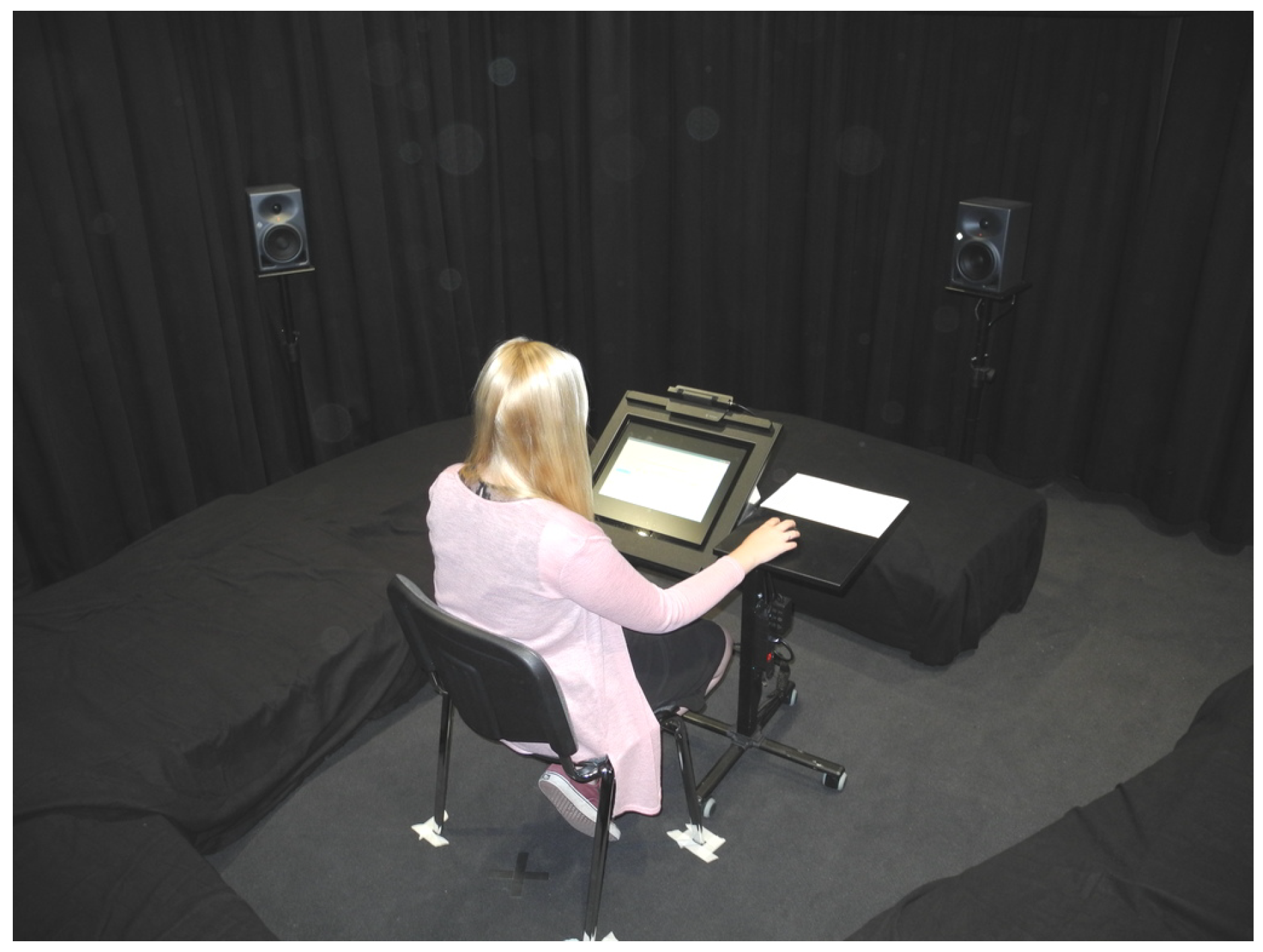

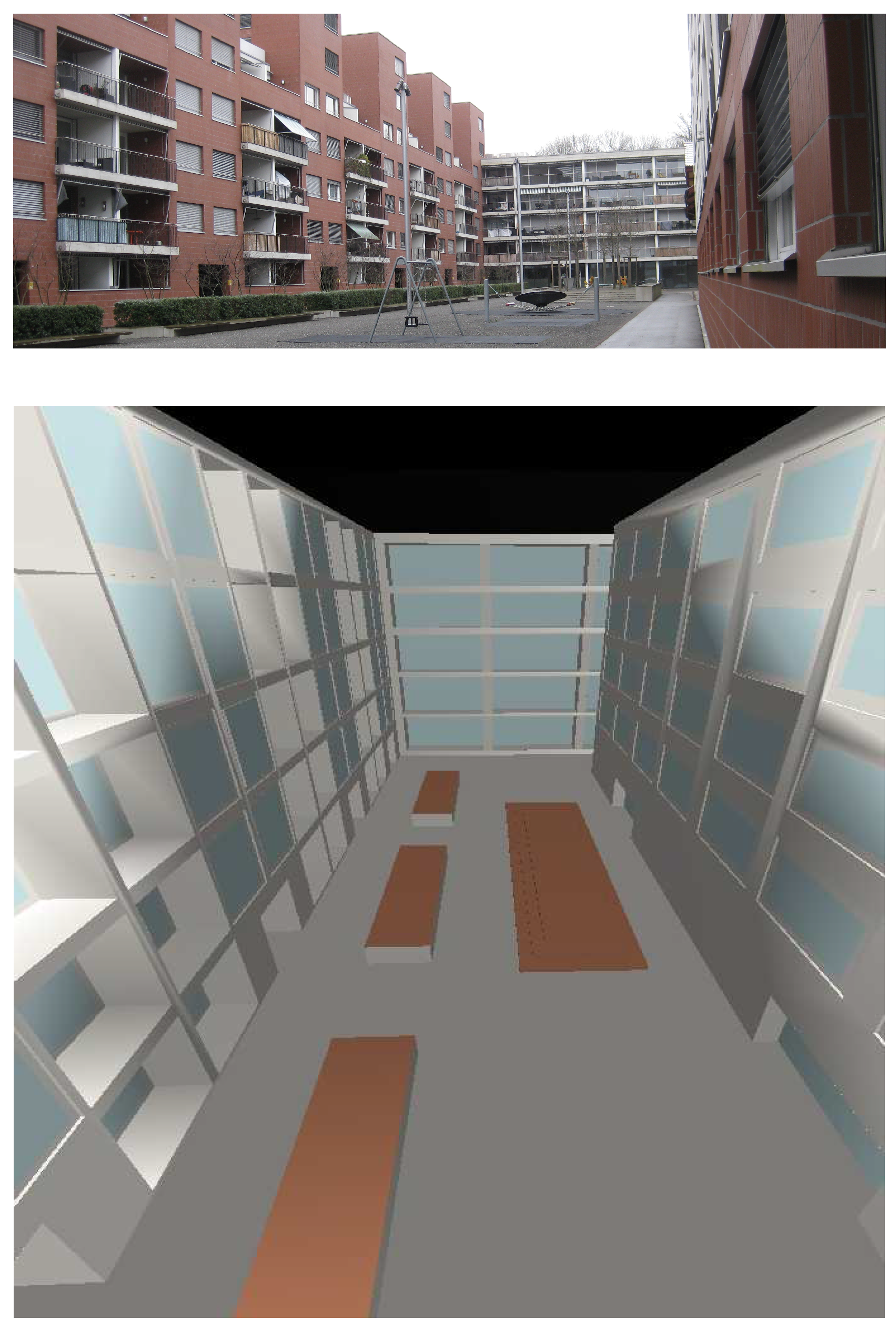
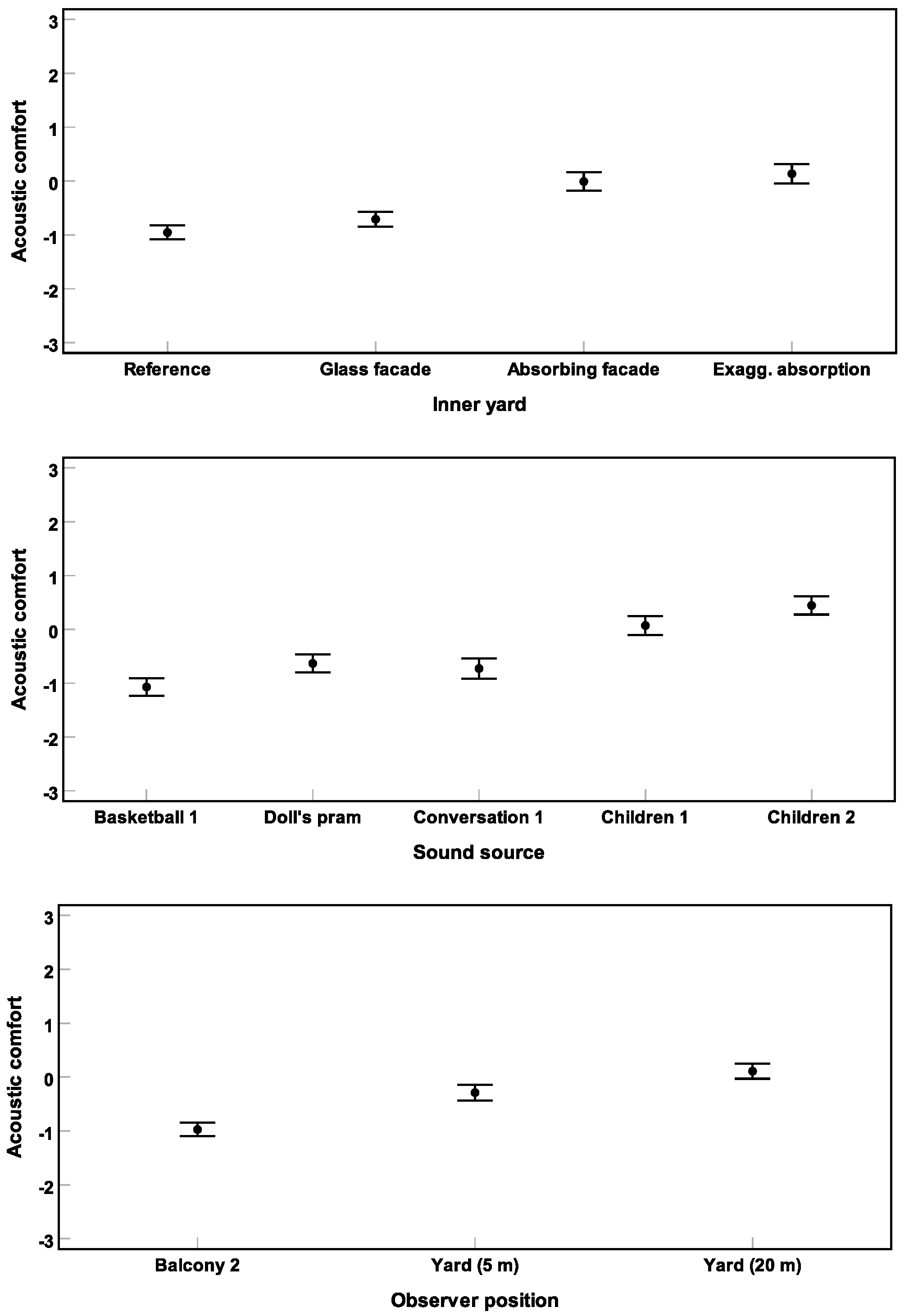
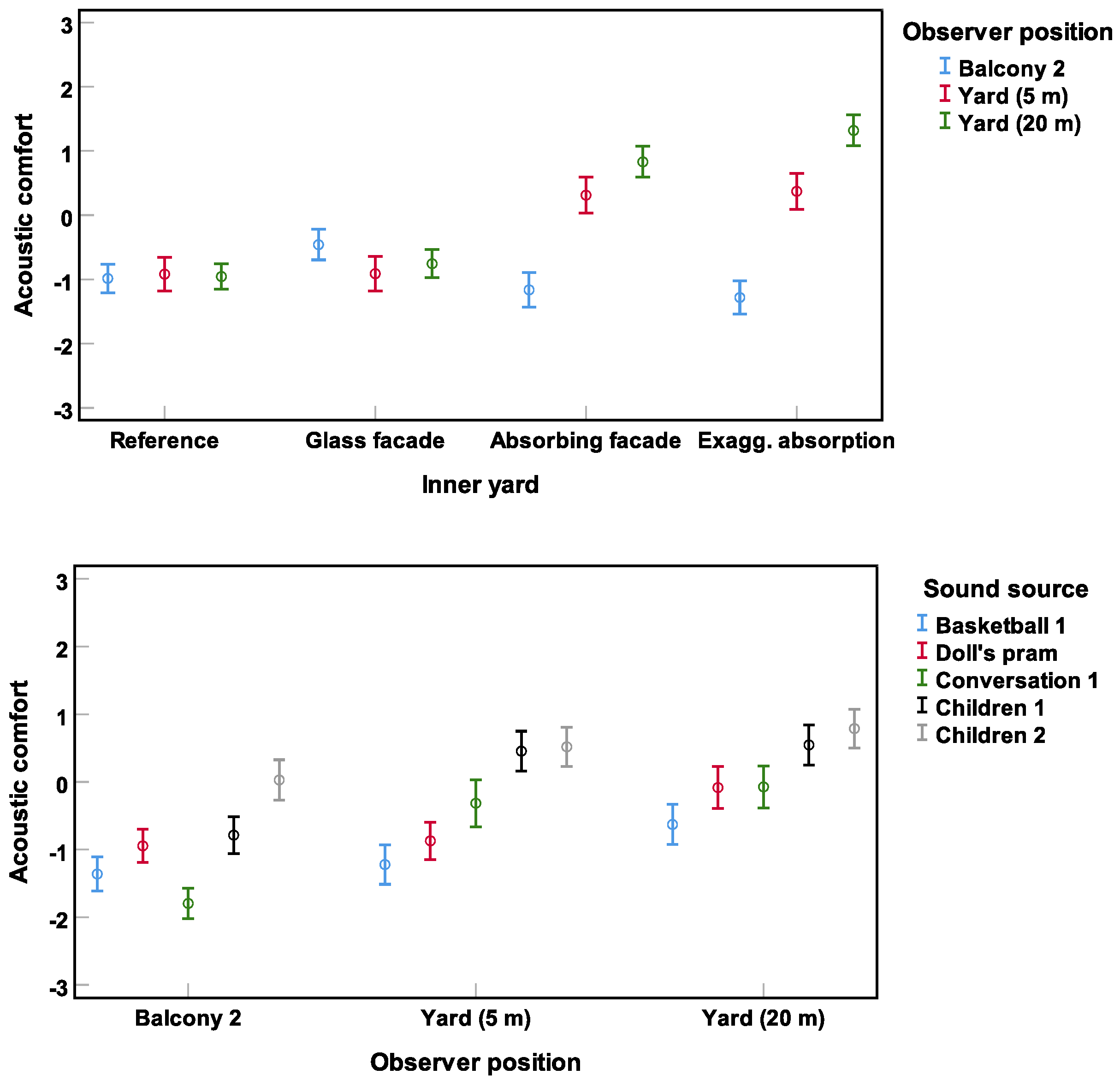

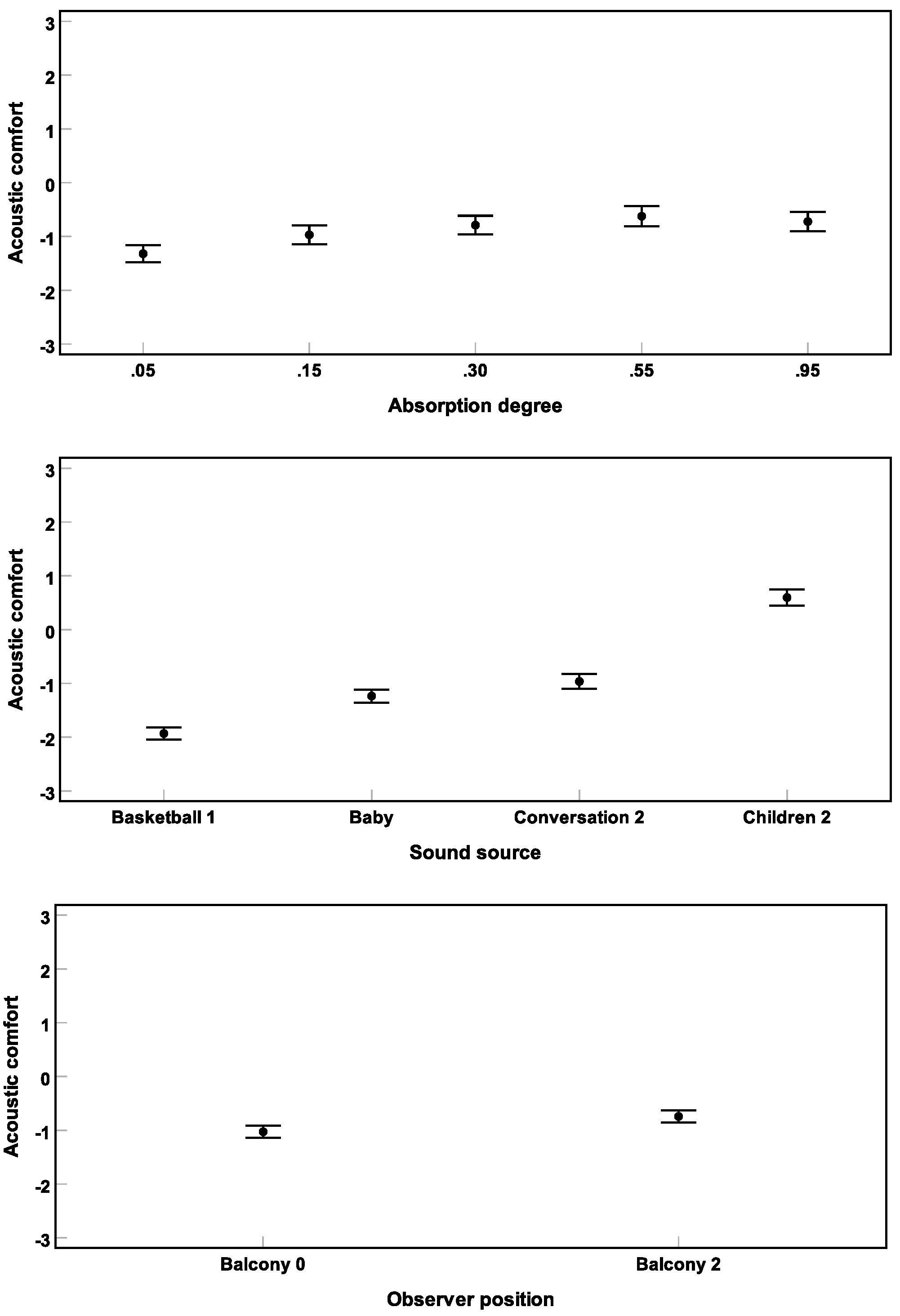


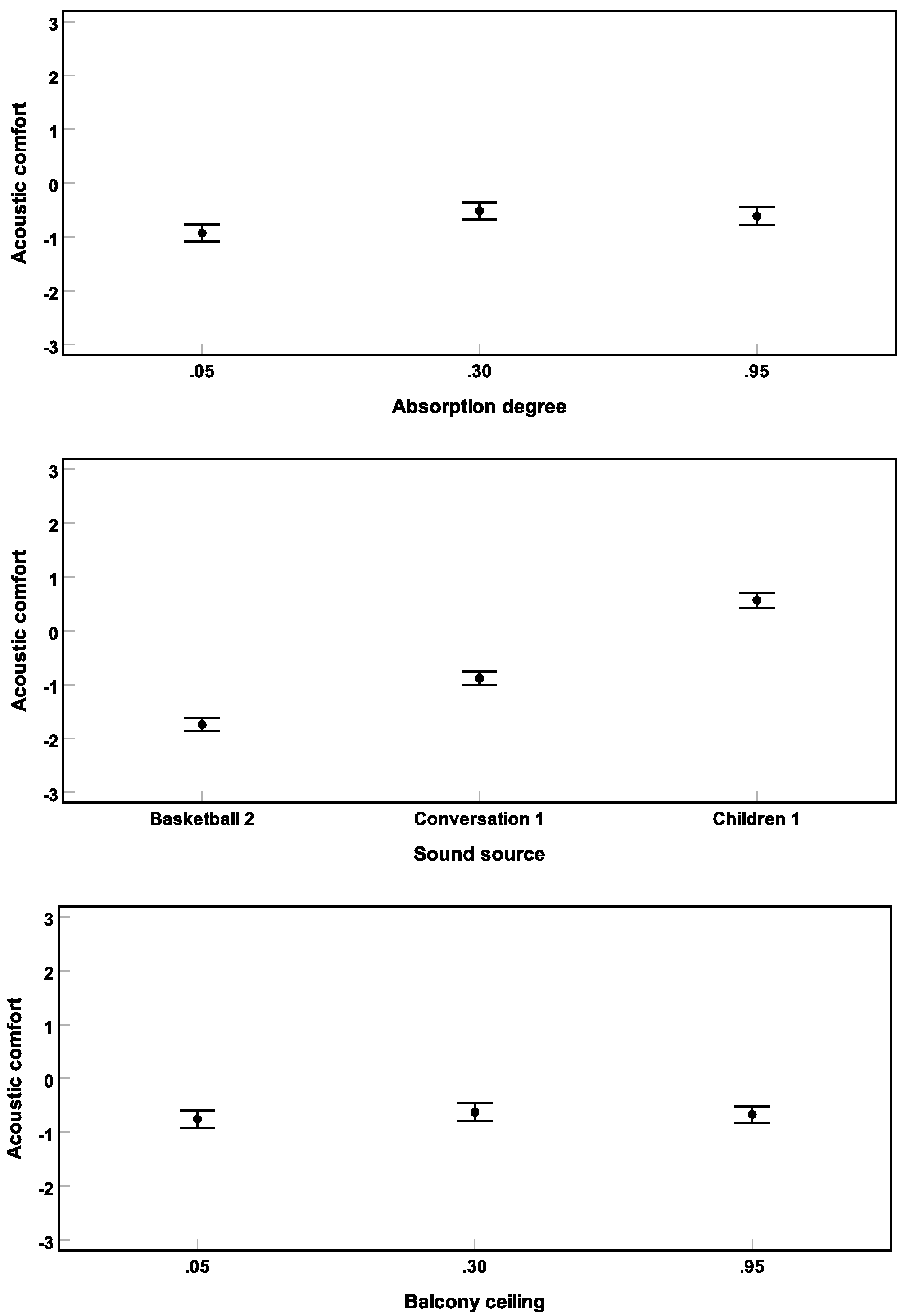
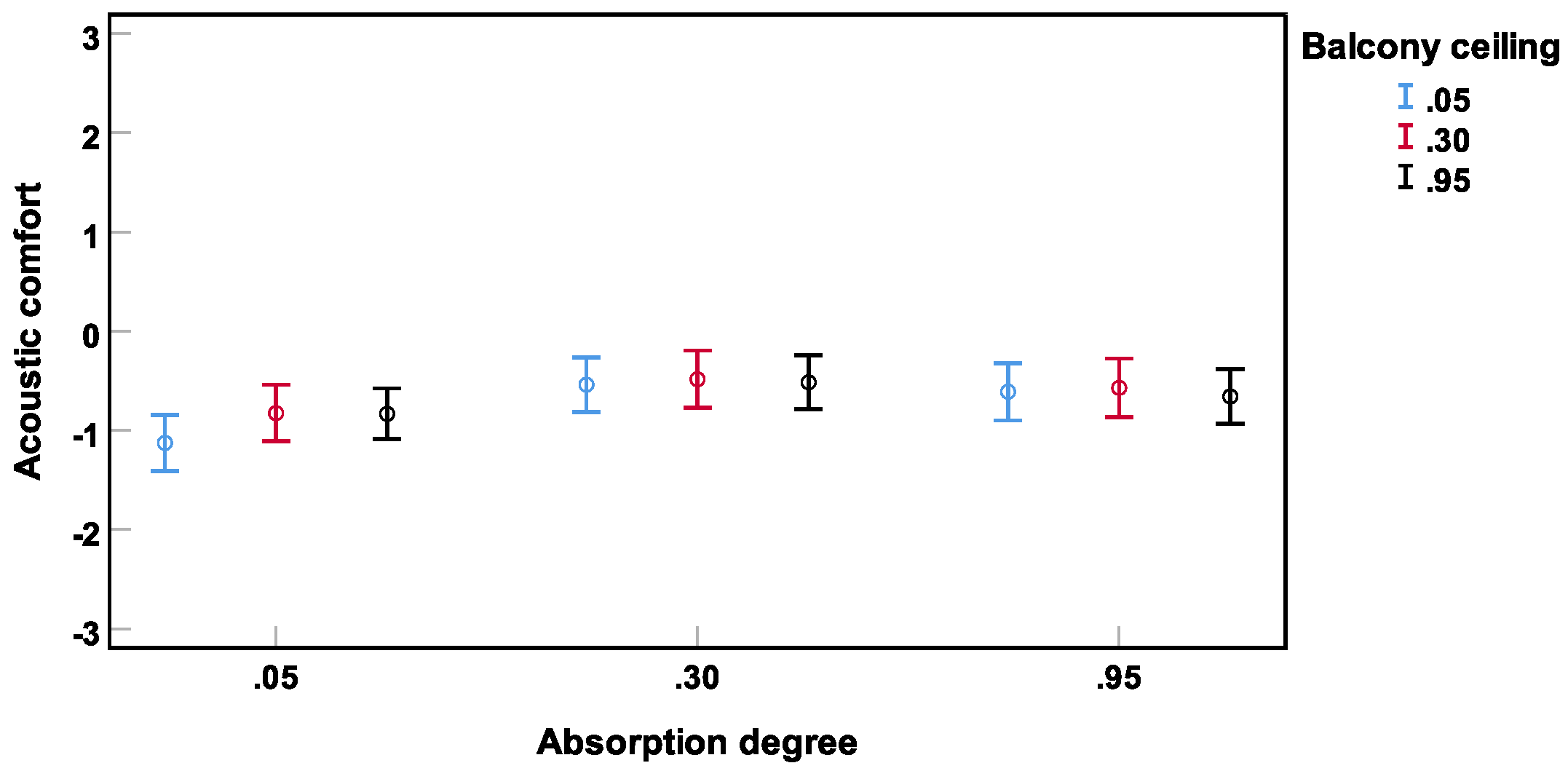
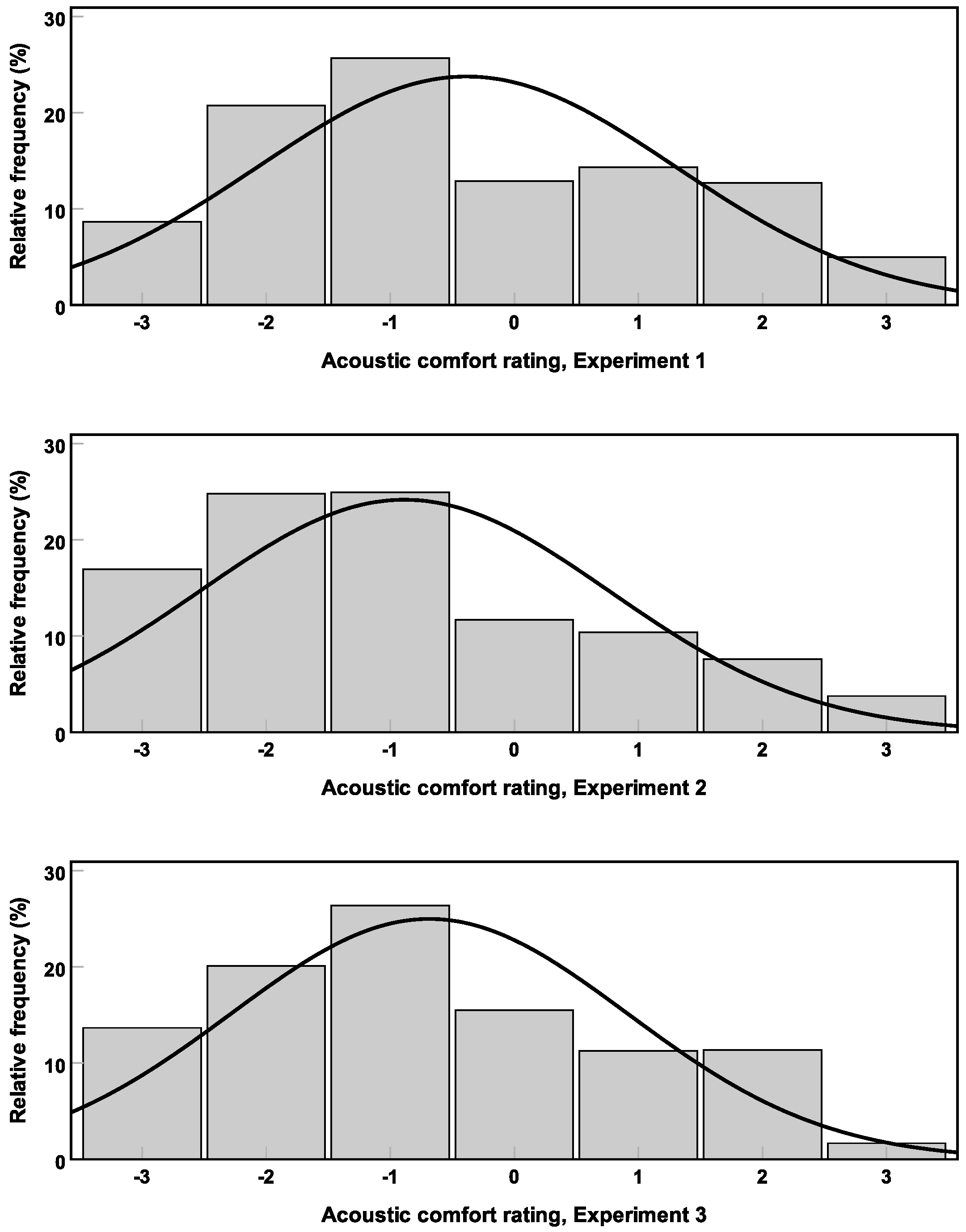
© 2019 by the authors. Licensee MDPI, Basel, Switzerland. This article is an open access article distributed under the terms and conditions of the Creative Commons Attribution (CC BY) license (http://creativecommons.org/licenses/by/4.0/).
Share and Cite
Taghipour, A.; Sievers, T.; Eggenschwiler, K. Acoustic Comfort in Virtual Inner Yards with Various Building Facades. Int. J. Environ. Res. Public Health 2019, 16, 249. https://doi.org/10.3390/ijerph16020249
Taghipour A, Sievers T, Eggenschwiler K. Acoustic Comfort in Virtual Inner Yards with Various Building Facades. International Journal of Environmental Research and Public Health. 2019; 16(2):249. https://doi.org/10.3390/ijerph16020249
Chicago/Turabian StyleTaghipour, Armin, Tessa Sievers, and Kurt Eggenschwiler. 2019. "Acoustic Comfort in Virtual Inner Yards with Various Building Facades" International Journal of Environmental Research and Public Health 16, no. 2: 249. https://doi.org/10.3390/ijerph16020249



